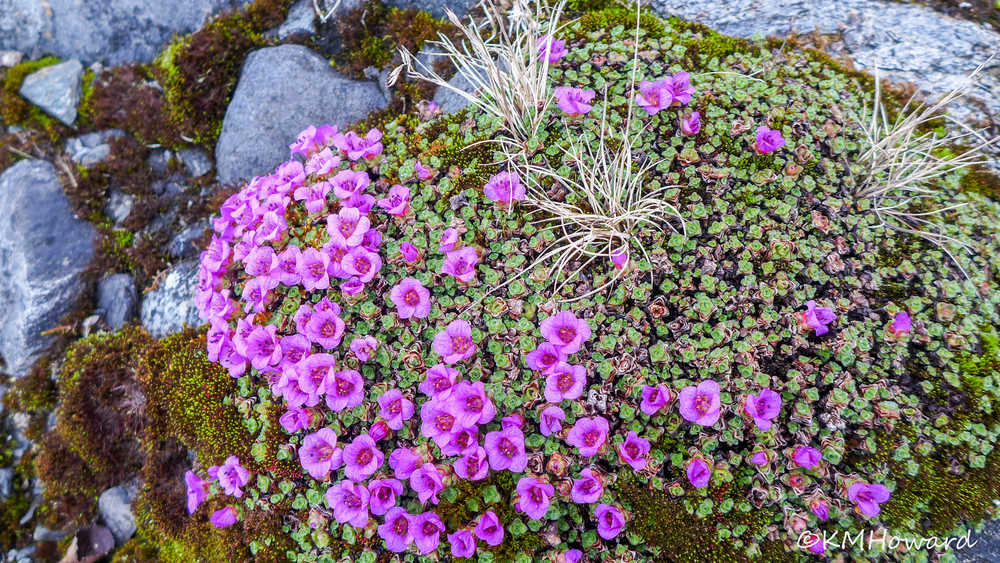The week that included the equinox brought a run of more nice weather, calling me out to note the signs of what seems to be an unusually early spring. As usually happens in Juneau, the development of spring-y signs varied a lot from place to place.
Skunk cabbage was just poking through to the surface in some low-elevation spots, but up, open, and flowering in others. All these early ones were in female phase, not a male-phase inflorescence to be found (each flower in the inflorescence is first female and then male). So no pollination was possible yet.
Pink salmonberry flowers decorated the nearly-leafless canes in the warm spots, and little, pinkish-white bells hung from some blueberry bushes. In some places, felt-leaf willows opened a few male catkins, but no female catkins were ready. Alder catkins (male) in certain locations were open and shedding pollen, and female cones were open and ready to receive that pollen, but in other places the males were compactly closed and no female cones were even visible.
Along Perseverance Trail, past the Horn, a cliff face glowed purple with another harbinger of seasonal progression. The cliff was studded with tufts of purple mountain saxifrage in full bloom. The cliffs near the glacier showed no purple yet, but just across the lake on the rock peninsula many clumps of saxifrage bloomed, and more were still to come. Some flowers were already faded a bit and past their prime.
We placed our feet carefully as we strolled along the rock peninsula, so as not to crush the saxifrage plants. Here we had an opportunity to inspect the saxifrage flowers closely, looking at those of different stages of maturity. The receptive stigmas of some flowers were already loaded with orange or yellow pollen from another plant.
A few bumblebees were flying about and may have been the agents of pollen transfer. Close inspection of the flowers revealed that the female parts matured before the male parts — those receptive stigmas were in flowers that had closed, pollen-filled anthers and therefore no self-pollen was yet available. I am left to wonder about the possible significance of the variation in color of the pollen, but I have found no sources that address that.
As we loafed in the sun on the rock peninsula, we heard hooters calling from the forested hillside. A couple of mountain goats were loafing, too, on a ledge near the high point of the peninsula. Recent beaver activity had been very selective — only certain willows were cut — so we wondered what made those particular trees so desirable. We also were struck by the number of beaver-cut logs that still lay on the ground in the brush, not hauled down to more accessible lunching places.
A visit to the area where the Herbert and Eagle rivers join was good, too. As we stepped over the guard rail to go down into the woods, a doe looked up at us, warily. We waited, she waited too, and then she moved slowly off into the trees. As we went down along the river, she paralleled our route for several minutes, carefully looking and listening to our activity. She looked a little heavy-bodied and may have been carrying a fawn.
The sand flats were covered with tracks of deer, wolf, otter and geese. The goose footprints were so large, and the piles of digested dinners so large, that we tried to turn their makers into swans, but a quick look at the reference books showed us that swan prints would be even bigger (six or seven inches long!).
Small spruces had colonized some of the older, more stable sand flats. We noticed that those clustered around the alders looked very happy, while those out in the barren sands had a yellowish tone, possibly the result of nitrogen deprivation. Because alders house special nitrogen-fixing bacteria in their roots, we guessed that the soil around the bases of the alders was more nutrient-rich.
I heard the songs of Pacific wrens, juncos and varied thrush, as these songsters started to warm up their voices for the nesting season. Song sparrows were tuning up in the beach fringes. The robins were back, and hummingbirds on their way. Spring is so much fun!
• Mary F. Willson is a retired professor of ecology.

